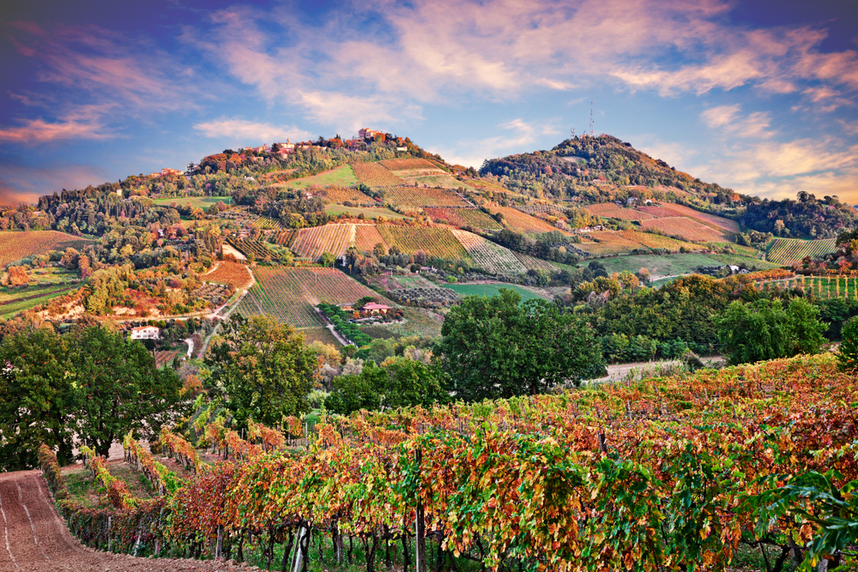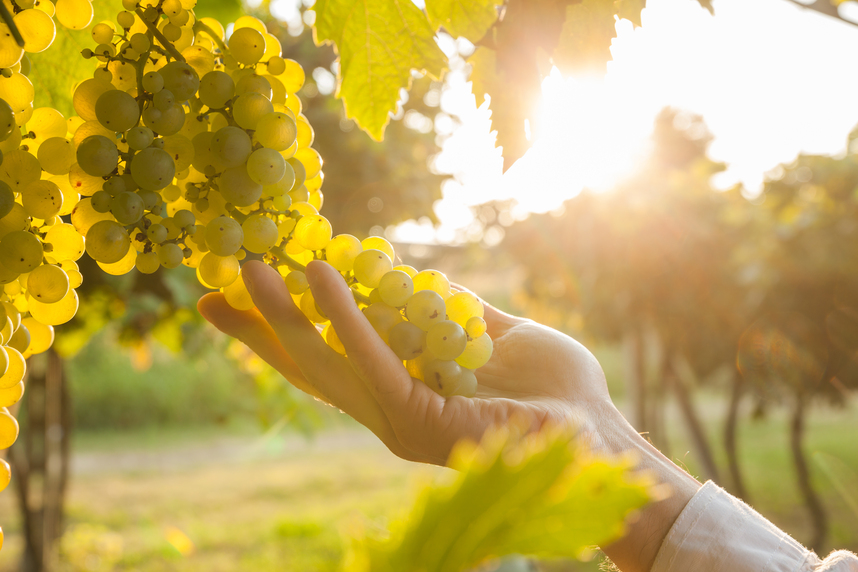The Trebbiano vine has found on the peninsula a favourable place to thrive, adapting to the different environmental conditions of its territory. Its malleability has allowed it to take root from North to South, gradually assuming the characteristics not of a single variety, but of a family composed of numerous declinations present in different Italian regions, from Veneto to Abruzzo. Versatile and lively, it gives rise to some of the most popular Italian white wines.
Here is the history, characteristics and food pairings of the excellent Trebbiano wines!
A bit of history: the Etruscan origins of Trebbiano
The history of Trebbiano is firmly linked to the very evolution of Italy, which saw its first great civilisation in the Etruscans. During their domination, the Trebbiano vine began to be cultivated in the hills of Romagna, vinified using conscious techniques. It was then the Romans who took the reins of this production, probably giving it the name by which it is known today - from the Latin trebula (farm), indicating a popular and homemade product - and also contributing to its massive diffusion throughout the Peninsula. In the writings of Pliny the Elder, for example, a vinum trebulanum is mentioned, produced near Capua.
The resonance of the grape variety during the Middle Ages was such that it even reached France - following the move of the papal seat to Avignon - under the name Ugni Blanc.
A true globetrotter, he did not limit himself to supplying the base blend for the production of Armagnac and Cognac, but also reached Portugal, Bulgaria, Argentina, Australia and the United States, conquering the foreign market with the vigour of his plants and the versatility of his wines, appreciated above all in blends, but also valid for vinification in purity.
The Trebbiano grape family, between terroir and organoleptic characteristics
The existing varieties of Trebbiano form a veritable family of vines, spread over areas that are also very different from one another. Its great adaptability, however, has earned it a reputation that is anything but flattering. For a long time considered a popular, everyday, low-quality wine - ideal for large-scale distribution and used above all in blends - the vine is recently experiencing a phase of redemption, conquering consumers with regional declinations of great personality!
The Trebbiano Toscano
With a larger area under vine than Sangiovese, Trebbiano Toscano can be found in many wines such as Toscana IGT Bianco, composed of Trebbiano, Malvasia and Vermentino. Emblematic is the case of the Vin Santo del Chianti DOC, to which these grapes lend a pleasant hint of acidity.
In purity, Trebbiano Toscano gives wines with a straw-yellow colour and a predominantly fruity aromatic bouquet, which tends not to stand out in terms of personality compared to the other members of the family. Among its distinguishing features, however, is its good acidity, which makes it a fresh and drinkable wine.
The credit for these characteristics is due to the terroir of the Trebbiano Toscano vine - mainly located in the region of the same name - characterised by a hot-dry climate, but not excessively dry. Trebbiano Toscano in fact appreciates fresh, regularly irrigated soils rich in clay and nutrients.
The Trebbiano Abruzzese

An indigenous grape variety of the region, it is grown in the provinces of Chieti, L'Aquila, Pescara and Teramo, along hilly belts located at an altitude of 150-600 metres above sea level, on sandy and clayey soils. The temperate belt guarantees mild springs and autumns, hot and dry summers and cold winters, due to the Balkan currents. The annual temperature fluctuations, as well as those between day and night, give the wine a distinct aromaticity.
Trebbiano Abruzzese is recognisable by its greater structure, which facilitates its vinification in purity, for example in 'Testarossa' Trebbiano d'Abruzzo Superiore DOP 2021. Characterised by a luminous straw yellow colour and delicate aromas of yellow-fleshed fruit, this wine also welcomes pleasant citrus scents, as well as the typical mineral and acidulous notes on the palate. The slightly almondy finish is accentuated with ageing.
The Trebbiano Romagnolo
Cultivated in the provinces of Forlì-Cesena, Ravenna, Rimini and in some municipalities of Bologna, this vine occupies a vast area, mainly facing the Adriatic Sea. Its privileged position guarantees it excellent sun exposure and adequate ventilation. The soils on which it grows luxuriantly are moraine and alluvial soils typical of flat areas and hilly ones rich in clay and limestone.
Also used for the production of balsamic vinegar, Trebbiano di Romagna grapes produce wines with a straw-yellow colour, characterised by green hues. Vinous and not too complex aromas include notes of apple and herbaceous tones, as can be seen in a glass of 1502 Da Vinci in Romagna 'Duomo di Faenza' Trebbiano Romagna DOC 2022. The sip is lively, fresh and savoury, with an almondy background note.
The Trebbiano di Soave
Between the provinces of Verona, Brescia, Mantua and Vicenza, Trebbiano di Soave is cultivated, which - as can be deduced from its name - is frequently used for the production of Lugana and Soave DOC wine, often in blends with a good percentage of Garganega
The Trebbiano di Soave grapes, which grow thanks to a temperate climate (with hot, dry summers and cool winters) on calcareous, clayey soils, give their wines a straw-yellow colour with bewitching green hues, good acidity, pleasant fruity and citrus notes and a slightly bitter taste on the finish.
The Trebbiano Spoletino
Again, it is the name that suggests the production area of Trebbiano Spoletino, an indigenous grape variety of Umbria, cultivated around the city of the same name, but also in numerous other municipalities in the province of Perugia. In this terroir, the plants adapt well to the mild climate and soils composed of clay and limestone, responsible for the mineral tones that characterise the wines.
The good productivity of the vine gives rise to numerous local products, such as 'Spoletino' Trebbiano Spoleto DOC 2022, which uses the vine in purity. In the glass, this wine displays a straw-yellow colour that veers towards green tones, and an aromatic bouquet that enhances hints of ripe fruit and citrus fruits, with a particular hint of flint. The taste reveals a soft and persistent flavour.
The Yellow Trebbiano
Trebbiano Giallo is not only found in one region, but in a wide area including Lombardy, Veneto, Latium, Umbria and Tuscany, where it grows in areas with very different characteristics (generally appreciating mild climates and hilly limestone-clay soils).
It is often used in blends - as, for example, in Frascati Superiore DOCG - but it can also be vinified on its own, producing wines with a light straw-yellow colour, fruity aromas, a typical almondy finish and the ever-present acidulous note that refreshes the drink.
Tasting tips for pairing Trebbiano wines with food
Beverino and popular, Trebbiano is a wine that proudly displays its extraordinary versatility at the table.
For a tasty aperitif with friends, the ideal candidate is a Trebbiano Romagnolo, which refreshes the palate from the heaviness of fried finger food - from fish and chips to chicken or cauliflower nuggets, from onion rings to scotched eggs - but which also goes very well with meat and fish delicacies, such as delicious mini sausage rolls or lighter, more elegant shrimp cocktails.
Those who appreciate vegetarian dishes can instead count on the softness and citrusy hints of a Trebbiano Spoletino, which can be served for example with legume or tomato soups, or with dishes accompanied by a tasty chickpea hummus.
If, on the other hand, the menu is mainly based on dishes with delicate hints - such as simple chicken or fish preparations - we recommend a Trebbiano d'Abruzzo, capable of enhancing - without covering up - the subtle flavours of white meats, cooked roasted, grilled, in savoury pies or soft flans, provided they are not enriched by overly intense seasonings. The same applies to seafood dishes: flans of haddock, salmon patties, tuna tartare (on its own or in a rich poké), or cod fillets with vegetables are at their best with this wine!
The pairings with Trebbiano wines do not stop at savoury dishes: biscuits, Apple Tarts and flavoured scones can be enjoyed during an afternoon or at the end of a meal together with a little Vin Santo, which livens up its sweetness precisely with a hint of acidity that characterises these products!
Want to learn more about Trebbiano wines? Explore the Svinando catalogue!

